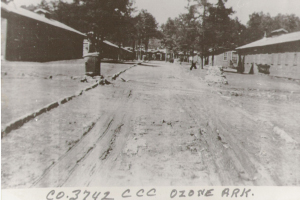Camp Ozone (3JO362)
The following is from Dr. Mary Brennan’s NEPA Heritage Report describing actions for Camp Ozone
CCC Camp Ozone was established to house approximately 200 men. Under the direction of regular Army officers, in 1935 enrollees cleared the camp site and lived in tents until it was possible to construct more permanent buildings. Although site plans differed for each camp, some elements were consistent. The flagpole and administration office were usually the first visible camp structures. Officers’ barracks were aligned in straight rows in front of enrollees’ tents or barracks. Other buildings included latrines, showers and washrooms, hospital and infirmary, kitchen and mess hall, administrative office, education or recreation building, garage and shop. Many camps include landscaping or other decorative elements particular to that camp. At Camp Ozone, for example, CCC enrollees constructed a goldfish pond in the shape of the state of Arkansas (Smith 1991).

Camp Ozone was home to two CCC companies. Company 1708 was organized in June 1933 at Camp Pike, Arkansas. It moved to Camp Frazier in Franklin County in June 1933. In October 1935, the company was moved to Camp Ozone where it stayed until 1938. Company 3742 was assembled at Oark in July 1935. It was moved to Camp Ozone in April 1939, where it was located until 1942. In additional to the economic benefits provided by the program, the CCC had dramatic social and educational impacts on enrollees. A 1935 report of the Department of Labor indicated that “CCC men returned to their homes definitely benefited physically and mentally; their out-look toward the future brighter” (Smith 1991:11). The War Department estimated an average weight gain of 12 pounds per enrollee, attributed to exposure to outdoor life, healthy food, and regular habits. Arkansas was nationally noted for the educational programs provided by the CCC. More than 2,000 Arkansas enrollees learned to read and write, many earning eighth grade diplomas. Camps provided opportunities to earn high school and college credits, as well as technical skills in land conservation, forestry, construction, woodworking and surveying.
The remains of Camp Ozone were recorded as archeological site 3JO0362 in 1993 during planning for the Ozone Campground Interpretive Development project (PN 93-10-04-03). A total of 29 site features were documented as well as three walkways and areas of domestic vegetation (iris, daffodils, yucca). In 1996, an additional feature – the powder magazine – was documented and added to the site form. The Camp is eligible for nomination to the National Register. In 2008-2009, the CCC Camp Ozone Interpretive Trail was constructed and opened to the public, with an approximately 0.25 mile handicap-accessible trail and signage interpreting camp history.
Smith, Sandra Taylor
1991 The Civilian Conservation Corps in Arkansas, 1933–1942. Arkansas Historic Preservation Program, Little Rock.